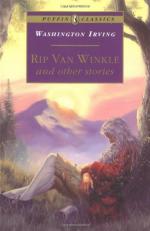
|
| Name: _________________________ | Period: ___________________ |
This test consists of 15 multiple choice questions and 5 short answer questions.
Multiple Choice Questions
1. Where is the village that Rip lives in?
(a) On the Atlantic coast.
(b) On the island of Manhattan.
(c) At the foot of the Catskill Mountains.
(d) At the foot of the Appalachian Mountains.
2. On page 29, the narrator says that a person might have "descried" the smoke from the village. What does this mean a person might have done?
(a) Seen it.
(b) Complained about it.
(c) Been puzzled by it.
(d) Explained its details.
3. On page 30, the reader learns that Rip is "obsequious" and his wife is a "termagant." What can accurately be said about their relationship?
(a) They have violent arguments with each other.
(b) They each have a skill that helps the other.
(c) One bullies the other.
(d) One is embarrassed by the other.
4. In the epigraph from Cartwright's play, to whom does the speaker swear that he will be honest?
(a) The Saxon god, Woden.
(b) The Celtic god, Alator.
(c) The Norse god, Odin.
(d) The Christian God.
5. Under what pseudonym was "Rip Van Winkle" published?
(a) Geoffrey Crayon.
(b) Washington Irving.
(c) Diedrich Knickerbocker.
(d) James Fenimore Cooper.
6. Who is the frame narrator of "Rip Van Winkle"?
(a) Washington Irving.
(b) James Fenimore Cooper.
(c) Diedrich Knickerbocker.
(d) Geoffrey Crayon.
7. On page 29, the mountains are said to be "lording it over the surrounding country." This is an example of which literary technique?
(a) Hyperbole.
(b) Personification.
(c) Onomatopoeia.
(d) Synechdoche.
8. In the frame narrative, the reader is told that the main story's narrator gets his information from the wives of the "burghers" (28). Whose wives are these?
(a) The wives of local indigenous leaders.
(b) The wives of prominent Dutch colonists.
(c) The wives of political officials.
(d) The wives of country farmers.
9. What is true of Rip's children in the beginning of the story?
(a) They are much more like their mother than like Rip.
(b) They refuse to speak to him.
(c) They are somewhat neglected.
(d) They are dangerously unsupervised.
10. From the description of Rip's attitude to his farm, on page 30, what can be deduced about Rip?
(a) He is devoted to his home and family.
(b) His farm is envied by many of his neighbors.
(c) His attitude toward his own family is similar to his attitude toward the villagers.
(d) He likes to make excuses instead of taking care of his responsibilities.
11. On page 29, the setting sun causes something to light up and glow "like a crown of glory." This is an example of what literary technique?
(a) Metaphor.
(b) Understatement.
(c) Simile.
(d) Alliteration.
12. Which nation controls New York at the time when Rip and the village are introduced to the reader?
(a) Holland.
(b) Great Britain.
(c) The United States.
(d) Sweden.
13. Who is "Dame" Van Winkle?
(a) Rip's sister.
(b) Rip's daughter.
(c) Rip's mother.
(d) Rip's wife.
14. What is Rip's dog's name?
(a) Dutch.
(b) Bear.
(c) Wolf.
(d) Dog.
15. What evidence does the frame narrator give that the main story's narrator is still well-liked?
(a) His picture is stamped onto new year's cakes.
(b) His portrait is hung in many local schools.
(c) There is a street in New York named after him.
(d) There is a children's rope-skipping rhyme about him.
Short Answer Questions
1. Where does Rip spend time with his friends?
2. When on page 31, the narrator refers to Rip's wife's nagging as a "torrent of household eloquence," what tone is created?
3. Who is Peter Stuyvesant?
4. What is Diedrich Knickerbocker's profession?
5. Who is the author of "Rip Van Winkle"?
|
This section contains 583 words (approx. 2 pages at 300 words per page) |

|




